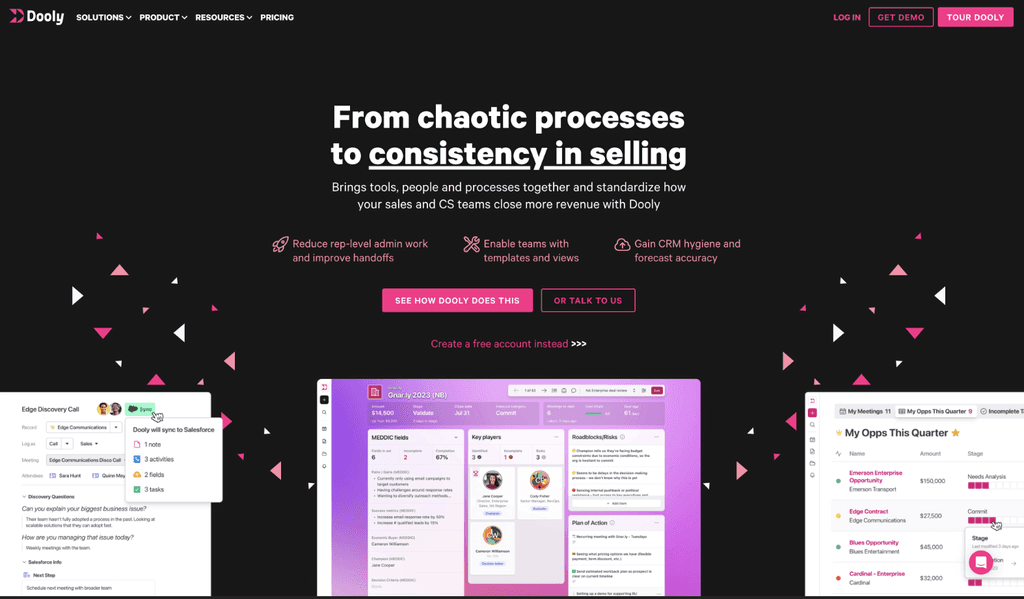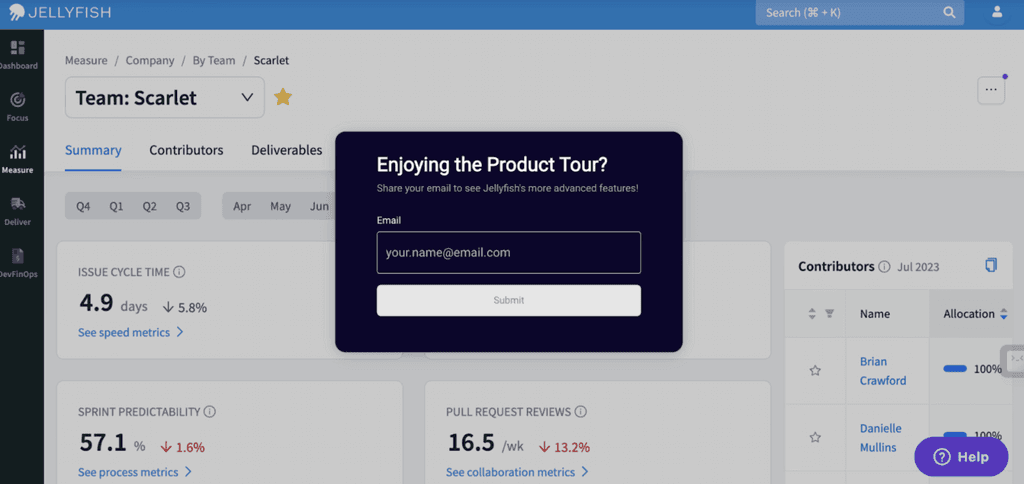The brand equity that once afforded legacy SaaS companies the luxury of lengthy, price-obscured sales cycles just doesn’t cut it anymore. Today’s buyers expect immediacy and transparency — they want to experience a product before ever speaking to a sales rep. But many say they struggle to find credible information.
According to the 2022 G2 Buyer Behavior Report, 35% of buyers say vendor content lacks credibility, and another 7% don’t trust vendor websites at all. That’s a problem, especially when all marketing channels eventually suffer from declining engagement (thanks to the Law of Shitty Clickthroughs). The solution? Lead with your product.
Instead of relying on traditional sales tactics, give buyers a hands-on experience from the start. Show them the value, the benefits—at the very first touchpoint. Interactive demos help marketing teams build trust (and pipeline), improve conversion rates, and, ultimately, close more deals.
Benefits of interactive demos for SaaS marketing teams
Before we get into how you can use interactive demos, let’s quickly go over how they can help different marketing teams perform better.
via Dooly
This “show, don’t tell” approach makes the value proposition clearer. Plus, with many buyers preferring not to talk to sales reps early in the evaluation process, it can be the bridge — giving them a hands-on experience early in the journey, making them more informed (and more likely to convert) when they finally reach sales.
Performance marketers — optimize demos and generate high-intent leads
Performance marketers thrive on data, and interactive demos provide real user engagement metrics. By tracking which features prospects interact with the most, you can refine ad messaging, targeting, and creative strategies to highlight features that resonate most with buyers. It’s real-time audience research, so you align your marketing strategies with evolving customer preferences.
Plus, a well-placed interactive demo can act as a lead magnet — offering prospects a hands-on experience in exchange for their contact details. You can use lead capture forms to collect contact information at the beginning, middle, or end of the demo, depending on your GTM strategy and buyer journey.
For example, fintech platforms like Maxio and Anrok use fully gated demos to ensure only serious prospects enter the funnel. Jellyfish, on the other hand, takes a semi-gated approach, allowing users to explore before prompting a sign-up.
Partner marketers — train partners and enable them to sell effectively
Channel partners extend your reach, but if they don’t fully understand your product, they can’t sell it effectively. Traditional partner enablement often involves lengthy training sessions, dense documentation, and one-off webinars — all of which are easy to forget and hard to revisit.
Interactive demos can change that. Partners can explore key features in real time, see how different use cases play out, and experience the value for themselves, reducing the need for live training sessions.
But not just that — you also make it easier for them to sell. Partners can walk prospects through your interactive demo in real time, letting them experience the value firsthand. So you don’t just train your partners but also give them on-demand sales enablement resources they can use to engage their leads.
And a side benefit to this: prospects see the same value and experience the same key benefits, irrespective of a partner’s sales style.
How different marketing teams can incorporate interactive demos
Now, let's move from theory to practice: how to implement interactive demos for real marketing (and revenue) gains, not just to check a box.
Interactive demo strategy for product-led growth (PLG) marketing teams
PLG is all about letting the product do the selling, so your demo strategy should make it effortless for users to explore, learn, and engage. Here’s how to use interactive demos at every stage of the journey:
Non-gated demos for a no-friction start
Not everyone wants to start a trial right away. Give visitors an easy way to experience your product without signing up. Embed interactive demos on your homepage, pricing page, or blog so they can explore key features with zero friction. The more they see the value, the more likely they are to convert.
Guided demos during onboarding
Trial users don’t always know where to start or which features will give them the biggest wins. Use guided interactive demos in your onboarding flow to highlight key features or set the right flow. The faster they find value, the more likely they are to stick around.
Embedded feature tours for upselling
Not everyone wants to start a trial right away. Give visitors an easy way to experience your product Want to nudge free users toward a paid plan? Embed interactive feature tours to show (not tell) them what they’re missing. Whether it’s an AI-powered automation, an advanced reporting tool, or a premium integration, let them see the benefits in action — right when they need it.
Interactive demo libraries for easy access
Not everyone learns the same way. Some users want a step-by-step walkthrough, while others prefer to poke around on their own. A demo library gives them the freedom to explore different features at their own pace.
Interactive demo strategy for enterprise marketing teams
Enterprise marketing isn’t just about driving leads. It’s about educating multiple stakeholders, proving value across departments, and keeping engagement high throughout the months-long sales cycles.
Interactive demos help marketing teams do this by providing self-serve, personalized experiences that cater to different roles within an enterprise. Here’s how:
Branched demos for role-specific experiences
Enterprise deals involve multiple decision-makers, each with their priorities. Marketing teams can use branched demos to ensure every stakeholder gets a relevant experience.
For executives: High-level overviews focused on business impact and ROI
For department heads: Use-case demos that highlight operational benefits
For IT teams: Security and integration-focused demos
Gated click-through demos to capture and qualify leads
Enterprise marketing teams typically generate, score, and qualify leads before passing them to sales. And gated click-through demos strike the perfect balance between lead generation and user experience.
Capture high-intent leads by requiring an email sign-up before accessing the demo.
Use engagement data (which features they explored, how long they interacted) to qualify leads.
Prioritize follow-ups based on demo engagement—marketing can score leads more effectively before passing them to sales.
Why does it matter? You can get better data on who’s really interested, allowing you to nurture leads with more personalized content before they even speak to sales.
Sandbox environment to support technical decision-makers
Enterprise purchases often require IT and engineering buy-in. Instead of waiting for sales to arrange a technical deep dive, marketing can provide a sandbox environment where developers can test APIs, integrations, and security protocols. This can:
Reduce friction by letting technical teams validate compatibility early.
Increase credibility by showing, not just telling, how your product works.
Support product-led storytelling — let prospects experience the value first-hand.
Using Interactive Demos to Drive Growth Across the PIE Framework
Source: MKT1
Interactive demos aren’t just a marketing tool — they’re one of your best growth accelerators. By embedding them strategically at every stage of the PIE Framework, you can expand reach, deepen engagement, improve conversions, and drive revenue growth. Here’s how:
Expand the pie — Test new markets or segments
When entering a new market or targeting a new segment, your messaging and positioning need to be validated quickly without committing too many resources.
Run A/B Tests with interactive demos: Create multiple versions of your product demo tailored to different industries, job roles, or pain points to see which one resonates most.
Use localized content: If expanding to an international market or a new industry, adjust the language and use cases shown in the demo to align with their needs.
Capture more of the same pie — Maximize market share in existing segments
For this, you need to remove friction in the buyer’s journey and giving prospects a reason to take action sooner.
Gate demos based on buyer readiness: Use semi-gated demos where users can explore a portion of the product before submitting their email.
Make interactive demos the CTA of your retargeting ads: If a prospect views your pricing page and doesn't convert, show them an ad with an interactive demo of key features.
Get more money from your slice of the pie — Increase revenue per customer
Expansion revenue depends on upselling, cross-selling, and feature adoption. Interactive demos help showcase premium features inside and outside the product experience.
Trigger in-product interactive walkthroughs: If a user isn’t using a key feature, trigger a contextual guided tour showing its benefits.
Create an expansion-focused interactive demo library: Give account managers and CSMs access to on-demand interactive demos they can send to existing customers for upsell conversations.
Interactive demo strategy for sales-led growth (SLG) marketing teams
Sales-led growth (SLG) relies on high-touch engagement, and sales teams take the lead in acquiring and converting customers. A marketer in an SLG team supports the sales team with resources to engage and nurture leads throughout the entire sales funnel, from initial awareness to final deal closure.
This includes creating compelling content and developing targeted campaigns. And interactive demos make for great sales enablement content.
Gated click-through demos to capture high-intent leads
Unlike PLG, where users can freely explore the product, SLG marketing needs to identify and qualify the best-fit leads before handing them to sales. Gated interactive demos help strike this balance. Gating demos helps filter out casual browsers and focus sales efforts on high-quality prospects.
Add a lead capture form at the beginning of your demos to collect lead information
Guided demos for demand generation campaigns
SLG marketing teams rely on targeted campaigns to drive inbound interest. Embedding interactive demos into landing pages, paid ads, and email nurtures makes campaigns more engaging and conversion-friendly.
We also suggest running interactive demo-driven ads. Instead of "Book a Demo," use "See the Product in Action" as a CTA. It’s less demanding and usually perceived as a low-pressure, no-commitment way to explore the product.
Best practices for creating buyer-first interactive product demos
An interactive product demo is only effective if it guides the prospect smoothly toward conversion. Here are some tips to make sure your demos are persuasive and conversion-friendly.
1. Identify the tipping point
Your product has a moment when everything clicks for a prospect (the AHA moment) and your interactive software demo should guide users to this moment as quickly as possible.
How to find your "AHA" moment
Look at user behavior in free trials: What’s the first action taken by users who convert?
Talk to sales and customer success: What’s the most common reaction when a prospect realizes your product's value?
Analyze heatmaps or session recordings: Where do engaged users spend the most time?
How to shorten the path
Remove extra steps: Skip the login screen, onboarding flow, or unnecessary setup
Pre-fill data: Let users see the product in action instead of starting from scratch.
Use feature highlights: Guide attention with pop-ups, arrows, or tooltips directing users to the core value.
2. Don’t sell hard — Use soft-sell demos
Your demo should feel like a helpful guide, not a sales pitch. You need to let the product speak for itself — because the more engaging the demo, the less selling is needed.
How to create non-intrusive demos
Avoid aggressive CTAs too early — “BUY NOW” pop-ups ruin the experience
Educate first, convert later — position your demo as a self-serve learning experience
Let users explore at their own pace — include optional deep dives into advanced features
How to balance selling and storytelling
Use subtle CTA placements like "Curious? See how teams save 10+ hours/week with this feature."
Add soft commitment prompts like "Want to try it with your data? Start a free trial."






